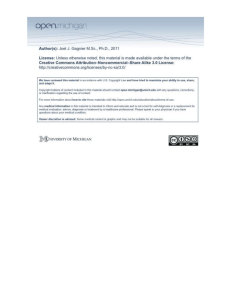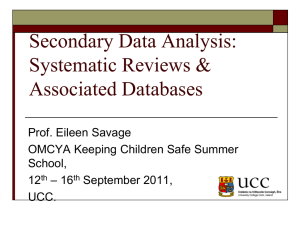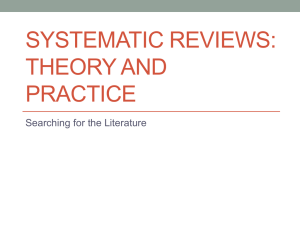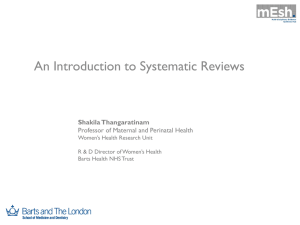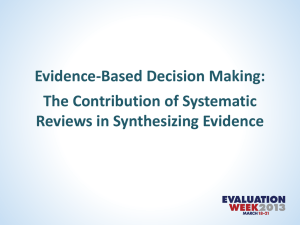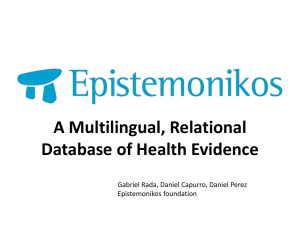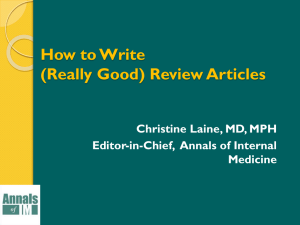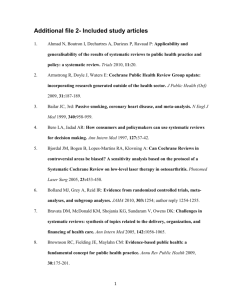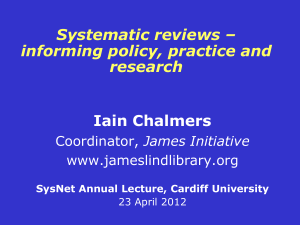Evidence Based Review
advertisement
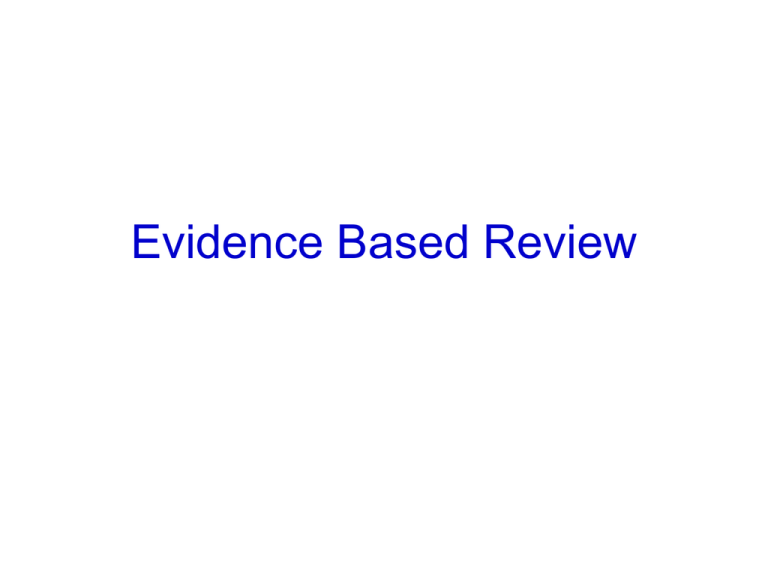
Evidence Based Review Introduction to Evidence Based Reviews • Systematic reviews comprehensively examine the medical literature, – seeking to identify and synthesize all relevant information – formulate the best approach to diagnosis or treatment. Examples are many of the systematic reviews of the Cochrane Collaboration or BMJ's Clinical Evidence compendium. • The best clinical review articles base the discussion on existing systematic reviews and meta-analyses, – incorporate all relevant research findings about the management of a given disorder. – provide readers with powerful summaries and sound clinical guidance. Am Fam Physician 2002;65:251-8. Key Elements of Evidence Based Reviews • Topic Selection • Searching the Literature • Patient-Oriented vs. Disease-Oriented Evidence • Evaluating the Literature • Levels of Evidence Am Fam Physician 2002;65:251-8. Topic Selection • Choose a common clinical problem and avoid topics that are rarities or unusual manifestations of disease or that have curiosity value only. • Whenever possible, choose common problems for which there is new information about diagnosis or treatment. • Emphasize new information that, if valid, should prompt a change in clinical practice. Am Fam Physician 2002;65:251-8. Patient-Oriented (POEM) vs. DiseaseOriented Evidence (DOE) • Concept of Patient-Oriented Evidence that Matters (POEM), in distinction to Disease-Oriented Evidence (DOE). – POEM deals with outcomes of importance to patients, such as changes in morbidity, mortality, or quality of life. – DOE deals with surrogate end points, such as changes in laboratory values or other measures of response. – Although the results of DOE sometimes parallel the results of POEM, they do not always correspond • When possible, use POEM-type evidence rather than DOE. • When DOE is the only guidance available, indicate that key clinical recommendations lack the support of outcomes evidence. Am Fam Physician 2002;65:251-8. Levels of Evidence Am Fam Physician 2002;65:251-8. Systematic review and Meta-analysis • Systematic review: Comprehensive literature search and critical appraisal of individual studies and uses appropriate statistical techniques to combine these valid studies. • Meta-analysis: Studies with relevant data are identified. Eligibility criteria for inclusion and exclusion of the studies are defined. Data are abstracted. Abstracted data analyzed statistically • … systematic literature review with various search terms and hand searched online journals and scanned reference lists of identified citations. We restricted the search to Medline (Ovid), Embase, CINAHL, Global Health, Web of Science, WHOLIS, LILACS, IndMed, grey literature (SIGLE), and Chinese language databases and to studies published between 1995, and 2010. Panel 1 shows study eligibility criteria. No language or publication restrictions were applied. • Two authors independently did the literature search and extracted data. Any disagreements were resolved after discussion. We invited participation of other researchers and contacted authors of published studies who had done similar population-based studies of paediatric influenza…. Comments by Zambon M, Health Protection Agency, London NW9 5HT, UK www.thelancet.com Published online November 11, 2011 DOI:10.1016/S0140-6736(11)61262-2 • …. Nair and colleagues present a rigorous systematic review and meta-analysis of a surprisingly weak evidence base. The investigators assessed ..40 different studies between …with different methodologies …Unsurprisingly in view of the studies’ heterogeneity, estimates for global hospitalisation and for overall mortality owing to influenza in 2008 (28 000–111 500 deaths) in children younger than 5 years need elaborate statistical imputation…..
